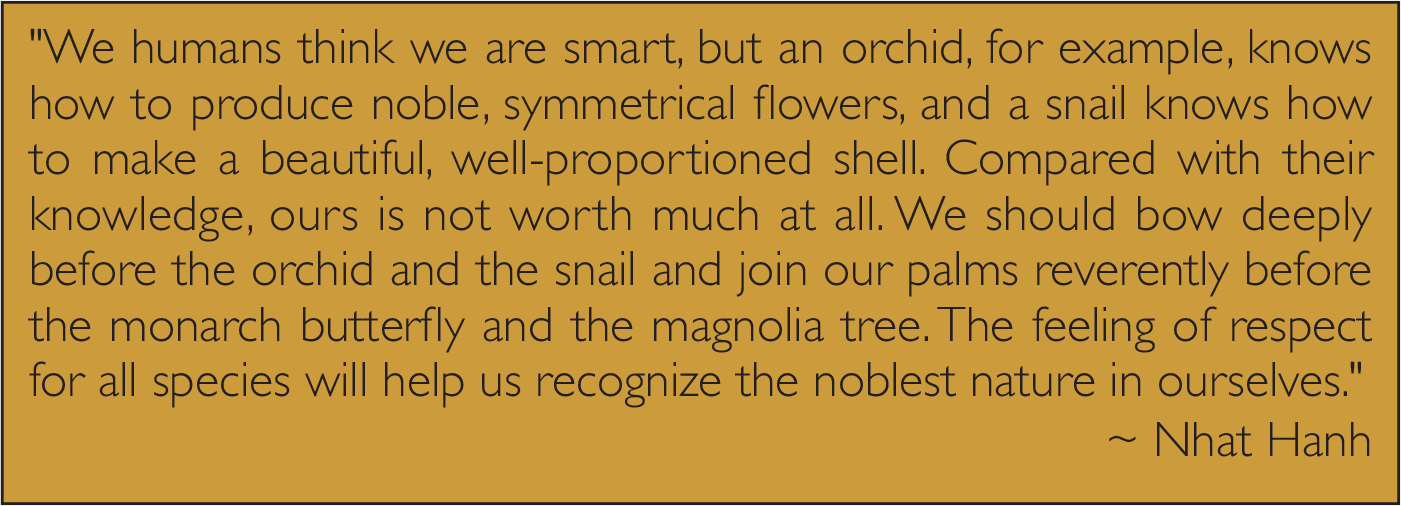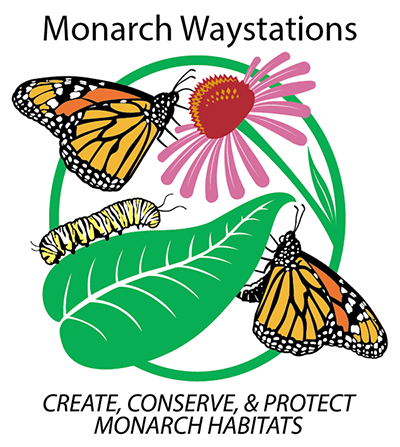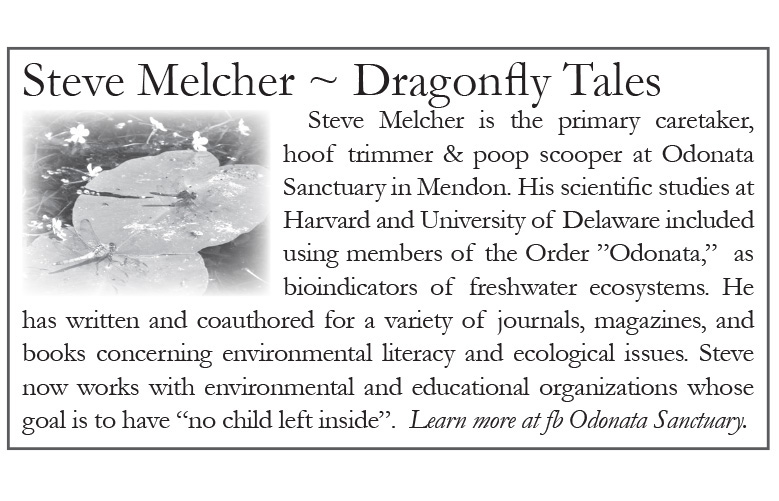Sunday, June 9, 2019
Tuesday, June 4, 2019
Nature as a place of peaceful reprieve
https://www.owllightnews.com/dragonfly-tales-nature-as-a-place-of-peaceful-reprieve/


Dragonfly Tales: Nature as a place of peaceful reprieve
by Steve Melcher –
 “In wildness is the preservation of the world.”
“In wildness is the preservation of the world.” 
~Henry David Thoreau
So spoke a true ‘Nature Boy’ over 100 years ago. Henry was someone who was seen as an ‘odd duck’, over educated and underemployed by his town’s folk. He was often seen sauntering through the woods of Lincoln and nearby Walden Pond where he built his now famous ‘cabin in the woods’. He sauntered seemingly with no direct purpose in mind, stopping here and there to observe a recently blooming flower or passing grasshopper. Sauntering is something that has become seldom seen in our swift superficial society. After all ‘saunter’ means to wonder in a slow and relaxed manner without hurry or effort. Here at Odonata Sanctuary, we are planning to build a replica of that cabin and other huts and hideaways of other nature writers. John Burroughs had his ‘Slabsides, still open to the public in West Park, NY. ‘The Shack’ is a rebuilt chicken coop along the Wisconsin River where Aldo Leopold crafted his conservation classic, A Sand County Almanac. Anne LaBastille’s wilderness cabin, famous worldwide for where she wrote the Woodswoman series of books, will be taken apart and transferred to The Adirondack Museum.
These special places are not just for nature writers. We all need a space to reconnect to nature…especially children. The IUCN (International Union for Conservation of Nature) World Conservation Congress provided dramatic support for the worldwide movement to re-connect children and nature—for their health and well-being and that of the Earth itself. The proposal states that children have a right to ‘equitable access’ to nature. Amazingly there are children near us in nearby cities that have never seen stars at night and only play on plastic ‘playgrounds’.
The IUCN adopted the resolution, “Child’s Right to Connect with Nature and to a Healthy Environment.” The resolution calls on IUCN’s government members, signers of the Jeju Declaration and NGOs to promote the Rights of the Child. Whew….all this and I just want to get my kid outside and have the ‘stink blown off him’.

Nature Deficit Disorder
What the Union, PCRM (Physicians Committee for Responsible Medicine), educators and many others including child psychologists are saying is that exposure to nature is as necessary to a child’s health as a healthy diet and exercise. A recent Yale study correlated children’s health with exposure to nature. In the study ‘The Nature of Americans’, Yale professor, Stephen R. Kellert, states: “The relationship of Americans and nature is changing.” Adults and children alike spend evermore time indoors, participation in outdoor activities beyond sports is stagnant or declining, and shifts in social expectations treat engagement with nature as a mere amenity. These trends pose a nationwide problem, since overwhelming evidence shows the physical, psychological, and social well being of humans depends on contact with nature. We’re finding a significant loss of exposure to nature with each generation. To many, Nature, ‘red in tooth and claw’, is to be feared and conquered. That fear has led to a separation from nature that is having dire consequences for our children. Children have an affirmative posture towards life. They have a natural curiosity. They are active beings who want to explore, experiment and build. As adults, all we need to do is provide the space and time for that exploration. We don’t need adults to show young children how to connect with nature. The space becomes the mediator. That space can be a local park or the tree in the backyard. Older children may want a mentor to further their natural curiosity about nature. We hope that our Odonata Sanctuary will become such a place in the near future.

Another finding that is shocking to me is the relationship between a child’s exposure to nature and feelings of loneliness. In their ‘Loneliness Experiment’ the BBC found that Loneliness is felt most intensely by young people. 40% of young people reported feeling lonely ‘often’ or ‘very often’, compared with 27% of the over 75s. The study concluded that ‘spending time in the natural environment – as a resident or a visitor – improves our mental health and feelings of wellbeing. It can combat loneliness and bind communities together.’ A pediatrician recently told me that loneliness has become as much of a factor of a child’s poor health as obesity and diabetes. 

Children that grow up exposed to nature, connected to nature, will have a greater chance of preserving the nature that they knew as children. If you expose your children to nature and allow those positive experiences to flourish, you create a future citizen who is more likely to preserve that experience through efforts to conserve wild areas. Children need nature as much as nature needs children. We owe our own story of our special place to our children and we owe them the preservation of ‘wildness’, for if ‘In Wildness is the preservation of the World’, who more deserves that preservation than our children: the future guardians of Earth?
You remember that special place you had as a sanctuary. Maybe down by the stream or even on the back step of your porch where you would ‘connect with nature’ while gazing at clouds or watching ants explore the concrete beneath your feet. I remember mine very well.
Give yourself permission to saunter and take a kid with you.

Further Reading:
The ‘Vitamin N Challenge’
Children and Nature Network (C&NN…not CNN) has created the ‘Vitamin N Challenge’ to bring together ideas for parents and practitioners to give their kids a healthy dose ofvitamin N. There is even a book titled Vitamin N, which presents over 500 nature-oriented actions and activities. Vitamin N The Essential Guide to a Nature-Rich Life: 500 Ways to Enrich Your Family’s Health & Happiness by Richard Louv
The Walden Project: I’ll be writing a whole article on this wonderful endeavor, but for now check out: https://www.walden.org
Thursday, May 9, 2019
Monarchs of the Sky
Dragonfly Tales: Monarch Butterfly
It’s a bird, It’s a plane!
No, it’s the Magnificent Mystical Marvelous
Migrating Monarch Butterfly!
by Steve Melcher –
In this age of Marvel comic book heroes like Spider-Man and Thor, a real life critter with amazing superpowers is the Monarch Butterfly – Danaus plexippus. The generation that we see in the North, goes through a transformation that rivals that of the Hulk. This last generation, actually referred to as the ‘Super Generation’, will fly from as far North as Maine and Manitoba and return to its winter woodland retreat in the mountains of Mexico. That same butterfly will rest for a bit, and when the weather conditions are right, fly across the border into Texas, lay eggs to begin a new generation that starts the mystical migration cycle again. Scientists still are unsure how the ‘Super Generation’ knows how to make its way back to the same small area of oyamel fir trees in the state of Michoacan in Mexico. In one experiment, monarchs were captured in Kansas, shipped to Washington D.C. and released. They immediately flew due south, many ending up in Florida. Those that were held in captivity for just a few days headed back to Mexico when released. The navigation mechanism might be related to sunrise and sunset observations allowing the monarchs to ‘reset’ their compasses.

I remember when we didn’t know where the monarchs ended up after their epic migration. The locals knew of the magnificent gathering of monarchs in the remote areas of Michoacan mountains, but associated the event with the Día de Muertos (Day of the Dead) and thought these must be the souls of ancestors. It wasn’t until the early 1970’s that a scientist, Dr. Fred Urquhart, after pursuing migrating monarchs for nearly 40 years, proposed that these were the same monarchs found up north. He told the world in the August, 1976 issue of National Geographic magazine. However, he did not reveal the actual location of the butterfly colonies, even to other scientists, until he was assured of their protection. The hypothesis was that these might be the same butterflies seen in the US and Canada that had flown south. While working on the Delmarva Peninsula with the Army Corp of Engineers in the 70’s, I worked with several colleges across the country tagging monarchs. The year 1975 was a ‘peak year’ for monarchs on the barrier islands, with dozens of orange butterfly beauties coating every goldenrod on the beach. Imagine the disbelief of finding your tag number from a butterfly caught and tagged on Wallops Island, Virginia, on a fir tree thousands of miles away in the mountains of Mexico. That small area, west of the heavily populated Mexico City, is still under pressure for development. The Mexican government has done a Herculean job of saving the areas where the monarchs overwinter despite the ongoing illegal logging and other development pressures. Thirty years ago the population was estimated to be over a billion. Today, it is less than 50 million. There have been ups and downs over the years. A cold spell decimated a portion of the population a few years ago. Storms along the migration route and climate change related temperature fluctuations have all contributed to population fluxes. The greatest impact has been due to habitat loss.
 The monarchs we see in the Finger Lakes of New York in the spring and summer might be the great-great-great-great-great grandkids of the monarch we saw leave for Mexico last fall. When the monarchs of the ‘Super Generation’ leave Mexico in the spring, they lay their eggs across the border in Texas. This first generation will fly further north, repeat the protocol of mating and then finding the proper plant to lay her eggs. The eggs of this first generation will hatch, eat, pupate and the adults will fly even further north, around 50 to 100 miles per day, searching for milkweed to lay their eggs. Along the way they are searching for nectar plants, for food and energy, and milkweed, to lay the next generation of eggs. Unfortunately, milkweed is considered a noxious weed by farmers and homeowners and is heavily sprayed with glyphosates and other herbicides. The spray not only kills the food sources and nurseries of Monarchs but affects many other species of pollinators as well. Farmers of everything from apples to almonds are now using a large portion of their budget to bring in bees and other pollinators to ensure a healthy crop. We can help the monarchs and the farmers by providing ‘Way Stations’ for monarchs and other pollinators by planting native milkweed and nectar plants. I want to stress the use of ‘native plants’. Native plants are adapted to local environmental conditions and migrating pollinators have adapted to these native plants. I also want to stress planting food and nursery plants. The infamous ‘Butterfly Bush’ (Buddleia sp.) has become an invasive species in many parts of the US and provides only food and not a place for the monarch to lay her eggs.
The monarchs we see in the Finger Lakes of New York in the spring and summer might be the great-great-great-great-great grandkids of the monarch we saw leave for Mexico last fall. When the monarchs of the ‘Super Generation’ leave Mexico in the spring, they lay their eggs across the border in Texas. This first generation will fly further north, repeat the protocol of mating and then finding the proper plant to lay her eggs. The eggs of this first generation will hatch, eat, pupate and the adults will fly even further north, around 50 to 100 miles per day, searching for milkweed to lay their eggs. Along the way they are searching for nectar plants, for food and energy, and milkweed, to lay the next generation of eggs. Unfortunately, milkweed is considered a noxious weed by farmers and homeowners and is heavily sprayed with glyphosates and other herbicides. The spray not only kills the food sources and nurseries of Monarchs but affects many other species of pollinators as well. Farmers of everything from apples to almonds are now using a large portion of their budget to bring in bees and other pollinators to ensure a healthy crop. We can help the monarchs and the farmers by providing ‘Way Stations’ for monarchs and other pollinators by planting native milkweed and nectar plants. I want to stress the use of ‘native plants’. Native plants are adapted to local environmental conditions and migrating pollinators have adapted to these native plants. I also want to stress planting food and nursery plants. The infamous ‘Butterfly Bush’ (Buddleia sp.) has become an invasive species in many parts of the US and provides only food and not a place for the monarch to lay her eggs.Life Cycle
“Butterflies…flowers that fly and all but sing.” ~ Robert Frost
Females lay tiny white eggs usually on the underside of a milkweed leaf. The outer covering of the egg is hard and hydrophobic (sheds water) which keeps the larva from drying out or from being eaten by beetles, ants and other insects. The newly hatched caterpillar’s first meal is it’s egg case! After finishing that easy meal it feeds on its host plant and will eat only milkweed leaves for its entire caterpillar stage of about 10 days. Milkweed contains glycosides that are poisonous to predators. Another protective feature of the caterpillar is a pair of long filaments on each end of its body. One pair are actual antennae and the other pair are false antennae confusing a potential predator as to which end is which.
The black, yellow and white caterpillar molts several times as it grows, eating its shed skin after every molt. The caterpillar will eventually attach itself to the underside of a leaf or branch in an upside down J shape. This is the final molt which transforms the caterpillar into a luscious lime green jewel-like chrysalis, rimmed with shining gold jewels. During the next 2 weeks, the caterpillar becomes completely reorganized. The pupal or chrysalis stage may look sedentary but there is a magnificent transformation occurring. Near the end of this stage the chrysalis becomes dark on the inside with a clear shell, revealing the formation of the butterfly within.

The butterfly splits open the chrysalis shell and emerges with damp, crumpled and limp wings. Still hanging upside down, it will pump fluid through the veins of its ever expanding wings. A few hours late, the wings have fully expanded and dried, and if the conditions are right, the monarch will take its first flight and become a ‘flower that flies and all but sings’.
Monarch Waystations
Santuario de la Mariposa de Mendon: Monarch Waystation #10223
Part of our mission at Odonata Sanctuary is to create and maintain a Monarch Waystation to contribute to monarch conservation and help assure the continuation of the monarch migration in North America. We not only have several areas dedicated to néctar plants but also encourage the propagation of native milkweeds. We currently mow 30 acres every other year to encourage ground nesting birds like Meadowlarks and Dickcissels. While I mow I keep an eye out for patches of milkweed and purposely mow around them encouraging the patch to expand. You don’t need 30 acres to create a sanctuary or waystation for monarchs. Most Monarch Waystations in project Monarch Watch are home gardeners like you. The Xerces Society, in partnership with the Monarch Joint Venture and National Wildlife Federation, has developed a list of native plants appropriate for our particular region.
For more information: https://monarchwatch.org/waystations/
Saturday, March 9, 2019
Subscribe to:
Posts (Atom)

